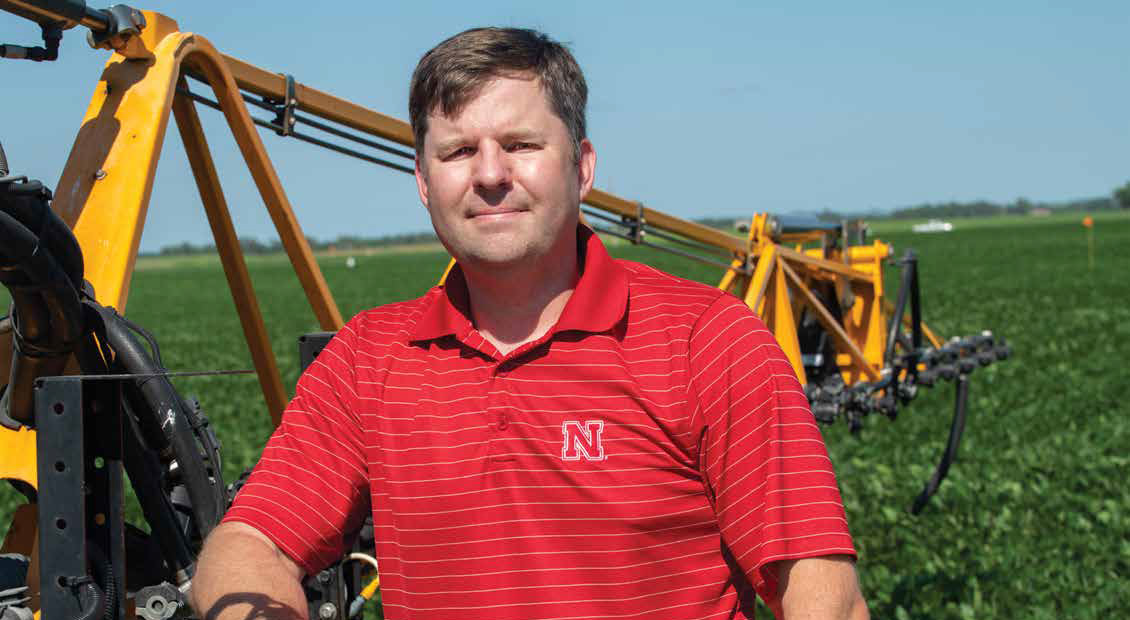
Reducing Spray Drift
Keeping Chemicals in Place

Chemicals have been used in agriculture since the early days of civilization. Chemical use can be traced back to when the Mesopotamians used elemental sulfur dusting as one of the first known pesticides. The practice has grown to a large sector of agriculture with fertilizers, herbicides and pesticides, all of which are strictly regulated by the Environmental Protection Agency. However, there are times where the chemicals fail to stay where they are intended.
Joe Luck, associate professor specializing in precision agriculture engineering in the Department of Biological Systems Engineering at the University of Nebraska–Lincoln, develops ways to make application systems more efficient in reducing spray drift.
Luck explained spray drift as chemicals being carried by an external force (wind, for example) to an area other than the original intended area. With the expanding use of chemicals in agriculture, wind is a natural factor producers often fight to keep applied chemicals in the intended space.
According to Luck, Nebraska is a great place to study this issue because “the wind in Nebraska is, on average, extremely high compared to most places. Those challenges that we deal with out here lead to innovation and that can be applied across different parts of the world.” Studying this issue in a place that has an abundance of one of the main factors to cause chemical spray drift puts Luck in a prime position to find the best ways to minimize it.
Agriculture is the No.1 industry in Nebraska. Luck said that farmland takes up 45.2 million acres, which is 90% of the state’s total landmass. Many producers use chemical application to keep up with growing food and fuel demands. Luck said that because drift is inevitable, it is imperative that producers do all they can to reduce spray drift. Minimizing spray drift protects Nebraska’s main industry and reduces chemicals introduced to the environment. Ultimately, minimizing spray drift is needed to protect other farmers, the public and the environment.

Causes and Solutions of Spray Drift
Luck said it is important to first understand the causes of spray drift so solutions can be made. Spray drift can be impacted by one or two operational factors. First, according to Luck, the droplet size of the chemical being applied plays an important role. Smaller droplet sizes have a higher probability of not reaching their intended target in the field.
“As far as the application goes, the droplet size is obviously critical to accurate application,” Luck said. When the sizes of droplets become small, drift potential grows.
Second, Luck said sprayer boom height can also impact spray drift. A sprayer boom is the mechanism in which spray nozzles are attached to distribute chemicals from the sprayer. If a sprayer boom is set to a height that is higher than necessary (many times by accident), there are higher chances of drift.
“If a 20-inch height is optimal for a certain setup that a farmer is using, any more above that would give more potential for spray drift,” Luck said.
Luck currently is developing a spray nozzle that will allow an operator to change droplet sizes while in the field. “If weather conditions change, larger droplets have less drift potential. Smaller droplets have a greater drift potential,” Luck said. “The ideal situation would be you'd have less chemicals moving off-target into the environment.”
Luck said his new spray nozzle accounts for different application practices of varying chemicals. Chemicals that only require a few drops per leaf to kill a plant would use larger droplet sizes, while other chemicals that require the leaf to be totally coated to be effective, would use smaller droplet sizes.
“There's potential that we could use this technology so farmers don't have to worry about making any changes on the sprayer. Just put in what droplet sizes are needed, the application rate and the control system compensates for that,” Luck said. This technology will allow operators to not have to make any adjustments manually on the machine. Instead, the system’s computer would take care of any adjustments needed. Luck said that easier control of droplet sizes reduces spray drift potential when accounting for external factors, and reducing spray drift has significant advantages.
Advantages of Spray Drift Reduction
Luck said that being more accurate in the application of chemicals and reducing spray drift has three specific advantages. First, by being more precise with where chemicals are applied, there are fewer chances of a neighboring producer being affected by the chemicals applied by another farmer. For instance, if a farmer grows a crop that becomes resistant to a type of chemical meant to kill plants, the farmer will spray the chemical but if spray drift occurs, the chemical could affect a neighbor.
“You can spray a field with weed killer and it'll kill the weeds in the field but not the herbicide-resistant crop. If you were a producer with a field next door that didn't have those hybrids and chemical drifted over there it may cause damage,” Luck said.
Second, reducing spray drift limits chemicals being introduced to the environment. “I think any time you can reduce environmental impacts, that will help the sustainability of crop production systems,” Luck said. Chemicals are an important part of production agriculture because they allow farmers to produce enough food to feed the growing population. However, Luck believes producers must ensure that the environment is minimally impacted.
Finally, Luck said using fewer chemicals also lowers the chances of chemical-resistant plants or pests. Chemical resistance is a result of improper application of an herbicide or pesticide, Luck explained. When a chemical that is intended to kill a weed only sickens the plant, the plant has the chance to come back stronger and produce seeds resistant to that chemical in the next year. This may then require a need for additional chemicals. Being more precise with application will lessen chemical-resistant weeds.
A Cost-Saving Option
Based on his past experiences, Luck notes that the farming industry can be a financial struggle. Commodity prices in 2019 have seen low numbers and farmers have been forced to find additional forms of income.
As a result, Luck acknowledged that few farmers are buying new equipment. Luck said, however, that farmers might benefit from a relatively low-cost spray nozzle.
“What you're seeing is that people may not be spending a lot of money on new equipment, but they might be spending a little money to upgrade technologies on their [current] equipment,” Luck said.